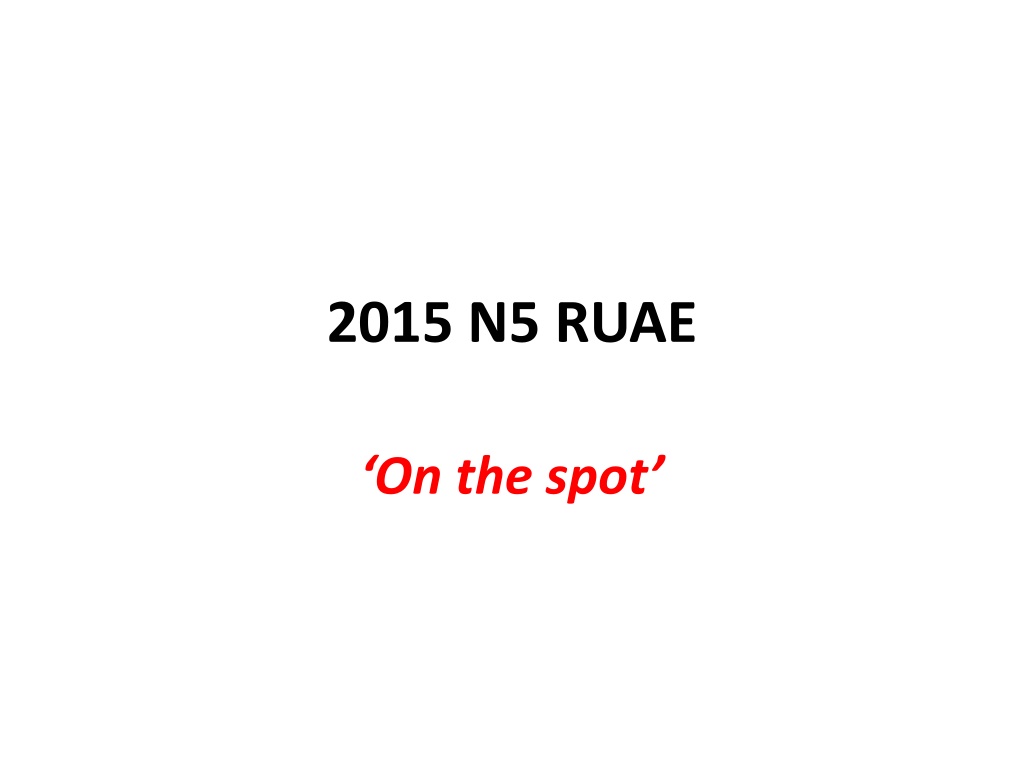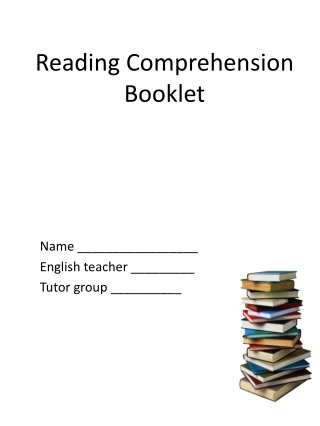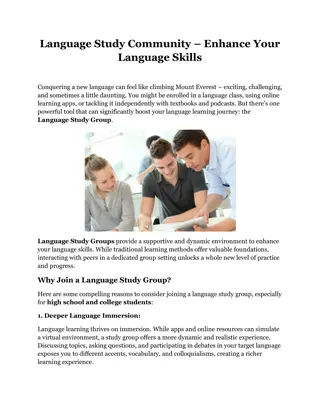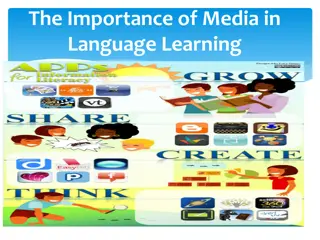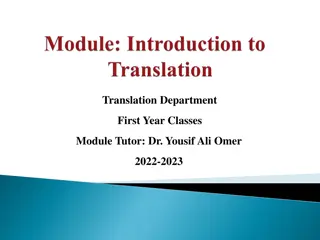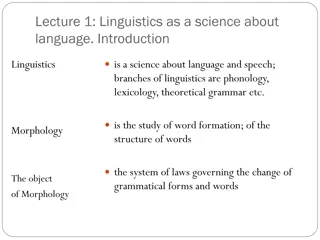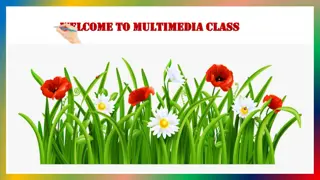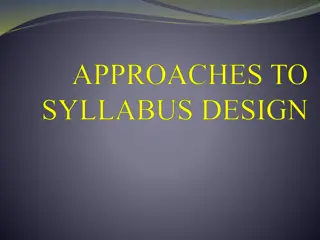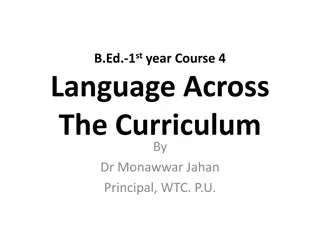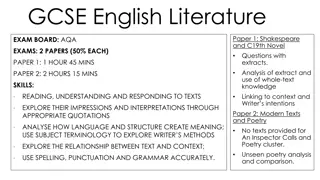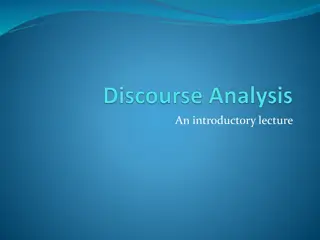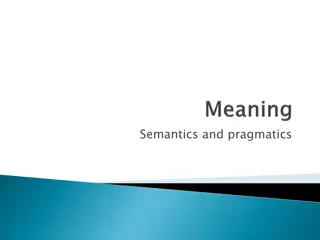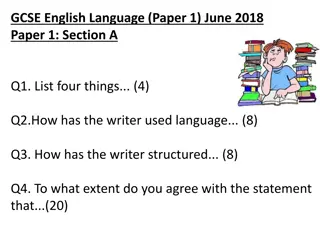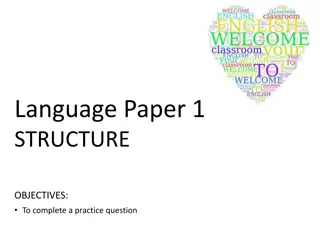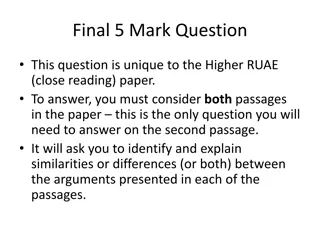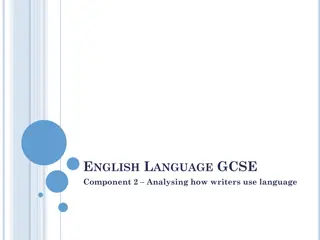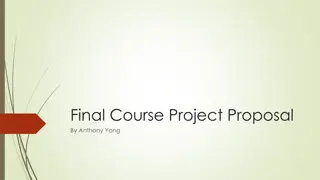Analyzing Passage Structure & Language Use
Academic passage analysis task focusing on evaluating paragraph effectiveness, language interpretation, attitude identification, and conclusion impact. Examine key points, word choices, and responses within the text for a comprehensive understanding.
Download Presentation

Please find below an Image/Link to download the presentation.
The content on the website is provided AS IS for your information and personal use only. It may not be sold, licensed, or shared on other websites without obtaining consent from the author.If you encounter any issues during the download, it is possible that the publisher has removed the file from their server.
You are allowed to download the files provided on this website for personal or commercial use, subject to the condition that they are used lawfully. All files are the property of their respective owners.
The content on the website is provided AS IS for your information and personal use only. It may not be sold, licensed, or shared on other websites without obtaining consent from the author.
E N D
Presentation Transcript
2015 N5 RUAE On the spot
Look at the sheet which you have been given. Highlight the important words in the questions and complete the instructions for how to answer the question.
1. Explain fully why the first paragraph (lines 14) is an effective opening to the passage as a whole. 3 three Any ______ _______ for _______marks. three points 2. Look at lines 5 10, and then explain in your own words what the writer means when he calls the response deeply ingrained . 2 ingrained gloss 1 mark for ________ of _______ + 1 mark for _____ of ___________ intensity deeply 3. Look at lines 14 21, and then explain in your own words two aspects of danger or threat we used to experience in the past, and two we face now. 4 your own words two Explain in ______________ ____ aspects of danger or threat for _________ experiences and ____________ experiences. two past two present
4. Look at lines 2237, and then summarise, using your own words as far as possible, some of the changes in the body which occur with the response. You should make five key points in your answer. 5 own words ___________, using your ___________, some of the ________ in the body which occur with the response. _____ mark for each _______. One point Summarise changes 5. Explain why the sentence How to deal with these responses? (line 44) provides an appropriate link at this point in the passage. 2 As above! 6. Look at lines 50 54, and then explain how two examples of the writer s word choice demonstrate the benefit of the response. 4 Explain _____ examples of the writer s ____________ which demonstrate the benefit of the response. _________ (1) plus ___________________ (1) x__ Reference appropriate comment word choice two 2
7. Look at lines 5561. Explain what the attitude of top athletes is to pressure, and how two examples of the language used make this attitude clear. 5 Explain two _______ the attitude of top athletes to pressure, and how _____ _________ of the language used make this ________ clear. examples attitude ____________ of attitude (1) Identification Reference 2 __________ (1) plus ____________________ (1) x__ appropriate comment 8. Look at lines 62 67, and explain fully using your own words why the advice to grab the opportunity might at first seem strange. 3 explain own words Fully _______, using your ___________, why the advice to grab the opportunity might at first seem strange. 1 Any ______ for __mark each. three
9. Pick an expression from the final paragraph (lines 6871), and show how it helps to contribute to an effective conclusion to the passage. You should refer to an expression or idea from earlier in the article. 2 expression Pick an __________ from the final paragraph and show how it helps to contribute to an __________________ to the passage. effective conclusion __________ from __________ (1) + Expression conclusion elsewhere linked _________ from __________ (1) reference
1. Explain fully why the first paragraph (lines 14) is an effective opening to the passage as a whole. 3 If you throw a rat into the middle of a room full of humans, it will instinctively freeze. By becoming completely still, it is more likely to avoid detection. Then, it will dart into a corner of the room, hoping to flee danger. If cornered, however, it will fight. Ferociously. Candidates should explain why the first paragraph is an effective opening for the passage. Be aware and award a mixed approach to this question. Any three points for three marks.
Now attempt to answer the questions. The answers are on the following slides.
1. Explain fully why the first paragraph (lines 14) is an effective opening to the passage as a whole. 3 If you throw a rat into the middle of a room full of humans, it will instinctively freeze. By becoming completely still, it is more likely to avoid detection. Then, it will dart into a corner of the room, hoping to flee danger. If cornered, however, it will fight. Ferociously. It shows / introduces / explains / describes / connects to (1) the idea (fight-flight-freeze) / theme / focus of the text /the rat (1) creates interest / shock / pathos /drama (1) Also accept: reference to second person / you (1) with chatty / informal tone (1) single word / minor sentence / short sentence / Ferociously! (1) series of short sentences (1)
2. Look at lines 510, and then explain in your own words what the writer means when he calls the response deeply ingrained . 2 Psychologists call it the fight-flight-freeze response, and it emerged very early in evolution. We know this because it is common to all vertebrates. The response starts in a part of the brain which reacts when an animal is confronted by a threat, and is controlled by the automatic nervous system. This is the same system that manages digestion and respiration, and is independent of conscious will. At the World Cup finals, we were given a neat insight into this deeply ingrained response. 1 mark for intensity of deeply + 1 mark for gloss of ingrained Glosses of both words: deeply eg very / completely / profoundly (1) ingrained eg embedded / fixed / rooted / established / intuitive / natural / instinctive / in a long standing fashion (1)
3. Look at lines 1421, and then explain in your own words two aspects of danger or threat we used to experience in the past, and two we face now. 4 In the modern world, we rarely face danger head-on. It is not like the good old days 15 when the fight-flight-freeze response was regularly called upon to deal with predators (of both an animal and human kind). Instead, the danger we face today is artificially created: taking an exam, giving a speech, taking a penalty. The psychological response, however, is the same. As footballers walk towards the spot, they are experiencing precisely the things you experience when put under pressure at 20 work. The threat is not to life or limb, but to ego and livelihood. We fear the consequences of messing up. Candidates should explain in their own words two aspects of danger or threat for two past experiences and two present experiences, from lines 14-21. Be aware of and award condensed answers.
3. Look at lines 1421, and then explain in your own words two aspects of danger or threat we used to experience in the past, and two we face now. 4 In the modern world, we rarely face danger head-on. It is not like the good old days 15 when the fight-flight-freeze response was regularly called upon to deal with predators (of both an animal and human kind). Instead, the danger we face today is artificially created: taking an exam, giving a speech, taking a penalty. The psychological response, however, is the same. As footballers walk towards the spot, they are experiencing precisely the things you experience when put under pressure at 20 work. The threat is not to life or limb, but to ego and livelihood. We fear the consequences of messing up. Past glosses of two: head-on eg direct / face to face (1) predators ...animal eg creatures (which wanted to harm / kill us) (1) predators ...human kind eg others like us (wanted to harm / kill us, eg through wars) (1) to life or limb eg real physical harm (1) regularly eg frequent (1) accept example of predator (1)
3. Look at lines 1421, and then explain in your own words two aspects of danger or threat we used to experience in the past, and two we face now. 4 In the modern world, we rarely face danger head-on. It is not like the good old days 15 when the fight-flight-freeze response was regularly called upon to deal with predators (of both an animal and human kind). Instead, the danger we face today is artificially created: taking an exam, giving a speech, taking a penalty. The psychological response, however, is the same. As footballers walk towards the spot, they are experiencing precisely the things you experience when put under pressure at 20 work. The threat is not to life or limb, but to ego and livelihood. We fear the consequences of messing up. Present glosses of two: artificial eg non-physical / psychological (1) to ego eg to pride / self-esteem / vanity (1) to livelihood eg to job / earnings (1) (consequences of) messing up eg doing it wrong (1) gloss of taking exam (1) / giving a speech (1)/ taking a penalty (1)
4. Look at lines 2237, and then summarise, using your own words as far as possible, some of the changes in the body which occur with the response. You should make five key points in your answer. 5 There is an acceleration of heart and lung function. There is paling and flushing. There is an inhibition of stomach action, such that digestion almost completely ceases. There is a constriction of blood vessels. There is a freeing up of metabolic energy sources (fat and glycogen). There is a dilation of the pupils and a relaxation of the bladder. Perception narrows. Often, there is shaking. All of these things are incredibly useful, in the right context. They prime the muscles; they massively increase body strength in preparation for fighting or running. The increased muscle flow and blood pressure means that you become hyper-vigilant. The response is beautifully balanced for a simple reason: it helped our ancestors (and the ancestors of modern-day rats) to survive. But there is a rather obvious problem. The fight-flight-freeze response is great for fighting, freezing or fleeing, but it is terrible if you have to do something complex, or subtle, or nuanced. When you are taking a penalty, or playing a piano concerto, or marshalling the arguments necessary to pass a difficult interview, it is not helpful to have adrenalin pumping like crazy and perception obliterated by tunnel vision. You need to be calm and composed, but your body is taut, pumped and trembling. Referring to lines 22-37, candidate should summarise using their own words some of the changes in the body which occur with the response. 1 mark for each point. Be aware of and award condensed answers.
4. Look at lines 2237, and then summarise, using your own words as far as possible, some of the changes in the body which occur with the response. You should make five key points in your answer. 5 There is an acceleration of heart and lung function. There is paling and flushing. There is an inhibition of stomach action, such that digestion almost completely ceases. There is a constriction of blood vessels. There is a freeing up of metabolic energy sources (fat and glycogen). There is a dilation of the pupils and a relaxation of the bladder. Perception narrows. Often, there is shaking. Changes glosses of acceleration of heart ... function eg the heart beats more quickly (1) acceleration of ... lung function eg breath comes faster (1) there is paling and flushing eg the skin changes colour (1) there is an inhibition of stomach action, such that digestion almost completely ceases eg the intestines work less (1) there is a constriction (of blood vessels) eg (blood vessels) narrow (1)
4. Look at lines 2237, and then summarise, using your own words as far as possible, some of the changes in the body which occur with the response. You should make five key points in your answer. 5 There is an acceleration of heart and lung function. There is paling and flushing. There is an inhibition of stomach action, such that digestion almost completely ceases. There is a constriction of blood vessels. There is a freeing up of metabolic energy sources (fat and glycogen). There is a dilation of the pupils and a relaxation of the bladder. Perception narrows. Often, there is shaking. Changes glosses of there is a freeing up of metabolic energy sources (fat and glycogen) eg feel more energetic (1) there is a dilation (of the pupils) eg the eyes widen / expand / enlarge (1) a relaxation of the bladder eg waterworks loosen (1) perception narrows eg concentration is (more) focused (1) shaking / trembling eg shuddering or quaking or similar (1)
4. Look at lines 2237, and then summarise, using your own words as far as possible, some of the changes in the body which occur with the response. You should make five key points in your answer. 5 All of these things are incredibly useful, in the right context. They prime the muscles; they massively increase body strength in preparation for fighting or running. The increased muscle flow and blood pressure means that you become hyper-vigilant. The response is beautifully balanced for a simple reason: it helped our ancestors (and the ancestors of modern-day rats) to survive. Changes glosses of prime (the muscles) eg prepare / ready (the muscles) (1) increase body strength eg become stronger (1) increase ... blood pressure eg higher (blood pressure) (1) (become) hyper-vigilant eg more alert / pay more attention (1)
4. Look at lines 2237, and then summarise, using your own words as far as possible, some of the changes in the body which occur with the response. You should make five key points in your answer. 5 But there is a rather obvious problem. The fight-flight-freeze response is great for fighting, freezing or fleeing, but it is terrible if you have to do something complex, or subtle, or nuanced. When you are taking a penalty, or playing a piano concerto, or marshalling the arguments necessary to pass a difficult interview, it is not helpful to have adrenalin pumping like crazy and perception obliterated by tunnel vision. You need to be calm and composed, but your body is taut, pumped and trembling. Changes glosses of (adrenalin) pumping like crazy eg increase (in adrenalin) (1) taut eg tense / tightened (1) pumped eg ready (1)
5. Explain why the sentence How to deal with these responses? (line 44) provides an appropriate link at this point in the passage. 2 Sports psychology can be thought of as helping performers to manage a response (ie fight, flight, freeze) that has outlived, to a large extent, its usefulness. The players standing in the semi-circle holding hands are virtually motionless. It is a nice metaphor for the freeze response. The walk to the penalty spot is curiously self-conscious. You can almost hear the inner dialogue: Get out of here, run away! But I can t run away. I have to take this thing! How to deal with these responses? One way is with reflection. The next time you give a speech or are doing a job interview, take note of how you feel. Gauge the curious feeling of dread, the desire to run away, the way your heart is beating out of your chest. But do not let this intimidate you; instead, reflect that these are normal reactions and everyone experiences them: even Michael Jordan (a marvel from the free-throw line) and Roger Federer (who always looks unnaturally calm on Centre Court). The candidate must offer an explanation on how the sentence How to deal with these responses? in line 44 provides an appropriate link at this point of the passage. NB Marks can be gained without direct quotation from link.
5. Explain why the sentence How to deal with these responses? (line 44) provides an appropriate link at this point in the passage. 2 Sports psychology can be thought of as helping performers to manage a response (ie fight, flight, freeze) that has outlived, to a large extent, its usefulness. The players standing in the semi-circle holding hands are virtually motionless. It is a nice metaphor for the freeze response. The walk to the penalty spot is curiously self-conscious. You can almost hear the inner dialogue: Get out of here, run away! But I can t run away. I have to take this thing! How to deal with these responses? One way is with reflection. The next time you give a speech or are doing a job interview, take note of how you feel. Gauge the curious feeling of dread, the desire to run away, the way your heart is beating out of your chest. But do not let this intimidate you; instead, reflect that these are normal reactions and everyone experiences them: even Michael Jordan (a marvel from the free-throw line) and Roger Federer (who always looks unnaturally calm on Centre Court). These responses looks back (1) How / to deal or question (mark) looks forward (1)
5. Explain why the sentence How to deal with these responses? (line 44) provides an appropriate link at this point in the passage. 2 Sports psychology can be thought of as helping performers to manage a response (ie fight, flight, freeze) that has outlived, to a large extent, its usefulness. The players standing in the semi-circle holding hands are virtually motionless. It is a nice metaphor for the freeze response. The walk to the penalty spot is curiously self-conscious. You can almost hear the inner dialogue: Get out of here, run away! But I can t run away. I have to take this thing! How to deal with these responses? One way is with reflection. The next time you give a speech or are doing a job interview, take note of how you feel. Gauge the curious feeling of dread, the desire to run away, the way your heart is beating out of your chest. But do not let this intimidate you; instead, reflect that these are normal reactions and everyone experiences them: even Michael Jordan (a marvel from the free-throw line) and Roger Federer (who always looks unnaturally calm on Centre Court). OR These responses looks back (1) to actions of team-mates or inner dialogue (1)
5. Explain why the sentence How to deal with these responses? (line 44) provides an appropriate link at this point in the passage. 2 Sports psychology can be thought of as helping performers to manage a response (ie fight, flight, freeze) that has outlived, to a large extent, its usefulness. The players standing in the semi-circle holding hands are virtually motionless. It is a nice metaphor for the freeze response. The walk to the penalty spot is curiously self-conscious. You can almost hear the inner dialogue: Get out of here, run away! But I can t run away. I have to take this thing! How to deal with these responses? One way is with reflection. The next time you give a speech or are doing a job interview, take note of how you feel. Gauge the curious feeling of dread, the desire to run away, the way your heart is beating out of your chest. But do not let this intimidate you; instead, reflect that these are normal reactions and everyone experiences them: even Michael Jordan (a marvel from the free-throw line) and Roger Federer (who always looks unnaturally calm on Centre Court). OR How / to deal or question (mark) looks forward (1) to identification of strategy (may quote reflection ) (1)
5. Explain why the sentence How to deal with these responses? (line 44) provides an appropriate link at this point in the passage. 2 Sports psychology can be thought of as helping performers to manage a response (ie fight, flight, freeze) that has outlived, to a large extent, its usefulness. The players standing in the semi-circle holding hands are virtually motionless. It is a nice metaphor for the freeze response. The walk to the penalty spot is curiously self-conscious. You can almost hear the inner dialogue: Get out of here, run away! But I can t run away. I have to take this thing! How to deal with these responses? One way is with reflection. The next time you give a speech or are doing a job interview, take note of how you feel. Gauge the curious feeling of dread, the desire to run away, the way your heart is beating out of your chest. But do not let this intimidate you; instead, reflect that these are normal reactions and everyone experiences them: even Michael Jordan (a marvel from the free-throw line) and Roger Federer (who always looks unnaturally calm on Centre Court). OR reference to the ideas in the text before the link (1) reference to the ideas in the text after the link (1)
6. Look at lines 5054, and then explain how two examples of the writer s word choice demonstrate the benefit of the response. 4 One of the most creative sports psychologists has found that simply discussing the fight- flight-freeze response has huge therapeutic benefit. It takes the edge off. It makes an otherwise bewildering reaction (what on earth is going on inside me?) into a comprehensible one. To put it another way, the first stage of liberation from the tyranny of pressure is echoing the behaviour of our ancient selves. By referring to lines 50-54, the candidate must explain two examples of the writer s word choice which demonstrate the benefit of the response. Reference (1) plus appropriate comment (1) x 2
6. Look at lines 5054, and then explain how two examples of the writer s word choice demonstrate the benefit of the response. 4 One of the most creative sports psychologists has found that simply discussing the fight- flight-freeze response has huge therapeutic benefit. It takes the edge off. It makes an otherwise bewildering reaction (what on earth is going on inside me?) into a comprehensible one. To put it another way, the first stage of liberation from the tyranny of pressure is echoing the behaviour of our ancient selves. huge (1) eg considerable (1) therapeutic (1) eg it helps (1) It takes the edge off (1) eg it makes us calmer (1) (It makes a ... bewildering reaction) into a comprehensible one (1) eg (it turns a baffling/puzzling reaction) into one which we understand (1)
6. Look at lines 5054, and then explain how two examples of the writer s word choice demonstrate the benefit of the response. 4 One of the most creative sports psychologists has found that simply discussing the fight- flight-freeze response has huge therapeutic benefit. It takes the edge off. It makes an otherwise bewildering reaction (what on earth is going on inside me?) into a comprehensible one. To put it another way, the first stage of liberation from the tyranny of pressure is echoing the behaviour of our ancient selves. liberation (1) eg freeing (1) (liberation) from tyranny (1) eg from oppression (1) pressure (1) eg stress (1)
7. Look at lines 5561. Explain what the attitude of top athletes is to pressure, and how two examples of the language used make this attitude clear. 5 This, I think, is what top athletes mean when they repeat that otherwise paradoxical saying: Pressure is not a problem; it is a privilege . Talk to David Beckham, Sebastian Coe or Sir Chris Hoy and they will be perfectly open about their nerves and fear. But they also talk with great pride about facing up to them. They didn t see these human responses as signs of weakness but as opportunities to grow. They created mechanisms (often highly personal ones) to help them through. They seized every opportunity to face danger, and learnt from each experience. The candidate should explain the attitude of top athletes to pressure, and how two examples of the language used make this attitude clear with reference to lines 55-61. Identification of attitude (1) Reference (1) plus appropriate comment (1) x 2
7. Look at lines 5561. Explain what the attitude of top athletes is to pressure, and how two examples of the language used make this attitude clear. 5 This, I think, is what top athletes mean when they repeat that otherwise paradoxical saying: Pressure is not a problem; it is a privilege . Talk to David Beckham, Sebastian Coe or Sir Chris Hoy and they will be perfectly open about their nerves and fear. But they also talk with great pride about facing up to them. They didn t see these human responses as signs of weakness but as opportunities to grow. They created mechanisms (often highly personal ones) to help them through. They seized every opportunity to face danger, and learnt from each experience. Identification of attitude, eg pressure can be positive / beneficial (1) Possible answers include: paradoxical (1) / reference to paradox eg emphasises that expectation is worse than reality (1) Pressure is not a problem (1) eg bluntly states attitude (1) privilege (1) eg shows that this is something positive (1)
7. Look at lines 5561. Explain what the attitude of top athletes is to pressure, and how two examples of the language used make this attitude clear. 5 This, I think, is what top athletes mean when they repeat that otherwise paradoxical saying: Pressure is not a problem; it is a privilege . Talk to David Beckham, Sebastian Coe or Sir Chris Hoy and they will be perfectly open about their nerves and fear. But they also talk with great pride about facing up to them. They didn t see these human responses as signs of weakness but as opportunities to grow. They created mechanisms (often highly personal ones) to help them through. They seized every opportunity to face danger, and learnt from each experience. Identification of attitude, eg pressure can be positive / beneficial (1) Possible answers include: colon to introduce (1) motto/mantra (1) reference to alliteration (1) eg accentuates the positive (1) semi-colon after problem complements (1) the balance (1) balance / (idea of) antithesis of Pressure ... privilege (1) draws attention to the bilateral nature (1)
7. Look at lines 5561. Explain what the attitude of top athletes is to pressure, and how two examples of the language used make this attitude clear. 5 This, I think, is what top athletes mean when they repeat that otherwise paradoxical saying: Pressure is not a problem; it is a privilege . Talk to David Beckham, Sebastian Coe or Sir Chris Hoy and they will be perfectly open about their nerves and fear. But they also talk with great pride about facing up to them. They didn t see these human responses as signs of weakness but as opportunities to grow. They created mechanisms (often highly personal ones) to help them through. They seized every opportunity to face danger, and learnt from each experience. Identification of attitude, eg pressure can be positive / beneficial (1) Possible answers include: example(s) cited of famous sportsmen (1) suggests agreement (1) perfectly open (1) suggests acceptance (1) reference to but starting sentence (1) emphasises the contrast (1) great pride (1) emphasises how good they feel (1)
7. Look at lines 5561. Explain what the attitude of top athletes is to pressure, and how two examples of the language used make this attitude clear. 5 This, I think, is what top athletes mean when they repeat that otherwise paradoxical saying: Pressure is not a problem; it is a privilege . Talk to David Beckham, Sebastian Coe or Sir Chris Hoy and they will be perfectly open about their nerves and fear. But they also talk with great pride about facing up to them. They didn t see these human responses as signs of weakness but as opportunities to grow. They created mechanisms (often highly personal ones) to help them through. They seized every opportunity to face danger, and learnt from each experience. Identification of attitude, eg pressure can be positive / beneficial (1) Possible answers include: facing up to them (1) shows positive attitude to confronting them (1) they didn t see these ... as signs of weakness (1) provides a clear statement (1) They created mechanisms (1) suggests coping strategies (1)
7. Look at lines 5561. Explain what the attitude of top athletes is to pressure, and how two examples of the language used make this attitude clear. 5 This, I think, is what top athletes mean when they repeat that otherwise paradoxical saying: Pressure is not a problem; it is a privilege . Talk to David Beckham, Sebastian Coe or Sir Chris Hoy and they will be perfectly open about their nerves and fear. But they also talk with great pride about facing up to them. They didn t see these human responses as signs of weakness but as opportunities to grow. They created mechanisms (often highly personal ones) to help them through. They seized every opportunity to face danger, and learnt from each experience. Identification of attitude, eg pressure can be positive / beneficial (1) Possible answers include: grow (1) emphasises a chance to develop (1) seized (every opportunity) (1) shows they are keen (1) repetition of They at the start of a sentence / parallel structure (1) shows affirmative nature of the attitude (1)
8. Look at lines 6267, and explain fully using your own words why the advice to grab the opportunity might at first seem strange. 3 So, here is a piece of (free) advice: if you are given an opportunity to take the equivalent of a penalty, whether at work or anywhere else, grab it. Accept that you will feel uncomfortable, that your stomach will knot and that, at the moment of truth, you will wish to be anywhere else in the world. Think also, as you are about to perform, of the footballers at a World Cup who volunteered to step forward with the weight of a nation s expectations on their shoulders. The candidate should fully explain using their own words why the advice to grab the opportunity might at first seem strange by referring to lines 62-67. Any three for 1 mark each.
8. Look at lines 6267, and explain fully using your own words why the advice to grab the opportunity might at first seem strange. 3 So, here is a piece of (free) advice: if you are given an opportunity to take the equivalent of a penalty, whether at work or anywhere else, grab it. Accept that you will feel uncomfortable, that your stomach will knot and that, at the moment of truth, you will wish to be anywhere else in the world. Think also, as you are about to perform, of the footballers at a World Cup who volunteered to step forward with the weight of a nation s expectations on their shoulders. Glosses of: you will feel uncomfortable eg you will find it awkward / unpleasant / unnerving (1) your stomach will knot eg you will feel physically stressed (1)
8. Look at lines 6267, and explain fully using your own words why the advice to grab the opportunity might at first seem strange. 3 So, here is a piece of (free) advice: if you are given an opportunity to take the equivalent of a penalty, whether at work or anywhere else, grab it. Accept that you will feel uncomfortable, that your stomach will knot and that, at the moment of truth, you will wish to be anywhere else in the world. Think also, as you are about to perform, of the footballers at a World Cup who volunteered to step forward with the weight of a nation s expectations on their shoulders. Glosses of: at the moment of truth, you will wish to be anywhere else in the world eg at the critical / vital time (1) you would wish you were not doing it (1) a nation s expectations on their shoulders eg much is being hoped for you / pressure is applied / your patriotism is under test (1)
8. Look at lines 6267, and explain fully using your own words why the advice to grab the opportunity might at first seem strange. 3 So, here is a piece of (free) advice: if you are given an opportunity to take the equivalent of a penalty, whether at work or anywhere else, grab it. Accept that you will feel uncomfortable, that your stomach will knot and that, at the moment of truth, you will wish to be anywhere else in the world. Think also, as you are about to perform, of the footballers at a World Cup who volunteered to step forward with the weight of a nation s expectations on their shoulders. Glosses of: at the moment of truth, you will wish to be anywhere else in the world eg at the critical / vital time (1) you would wish you were not doing it (1) a nation s expectations on their shoulders eg much is being hoped for you / pressure is applied / your patriotism is under test (1)
9. Pick an expression from the final paragraph (lines 6871), and show how it helps to contribute to an effective conclusion to the passage. You should refer to an expression or idea from earlier in the article. 2 Because here is the most revelatory and paradoxical thing of all: if you miss, your life will not end. If you fluff your lines, you won t die. Instead, you will grow, learn and mature. And isn t that what life whether at home, on the football pitch, or in the office is ultimately about? The candidate should pick an expression from the final paragraph (lines 68-71) and show how it helps to contribute to an effective conclusion to the passage. + linked reference from elsewhere (1) Expression from conclusion (1) NB The linked reference may be to the passage as a whole.
9. Pick an expression from the final paragraph (lines 6871), and show how it helps to contribute to an effective conclusion to the passage. You should refer to an expression or idea from earlier in the article. 2 Because here is the most revelatory and paradoxical thing of all: if you miss, your life will not end. If you fluff your lines, you won t die. Instead, you will grow, learn and mature. And isn t that what life whether at home, on the football pitch, or in the office is ultimately about? Reference to an expression from earlier in the article should be made. Possible answers include: paradoxical (1) eg repeats word used earlier (line 55) (1) you will grow, learn and mature (1) eg revisits actual words grow (line 56) or learnt (line 57) or ideas of athletes profiting from the experience (1) on the football pitch (1) eg refers back to lines 9-12 or the title (1)
9. Pick an expression from the final paragraph (lines 6871), and show how it helps to contribute to an effective conclusion to the passage. You should refer to an expression or idea from earlier in the article. 2 Because here is the most revelatory and paradoxical thing of all: if you miss, your life will not end. If you fluff your lines, you won t die. Instead, you will grow, learn and mature. And isn t that what life whether at home, on the football pitch, or in the office is ultimately about? Reference to an expression from earlier in the article should be made. Possible answers include: in the office (1) eg refers back to job interview (line 45) or at work (lines 19-20) (1) fluff your lines (1) eg refers back to giving a speech (line 17) (1) if you miss (1) eg refers back to taking a penalty (line 17) (1)
